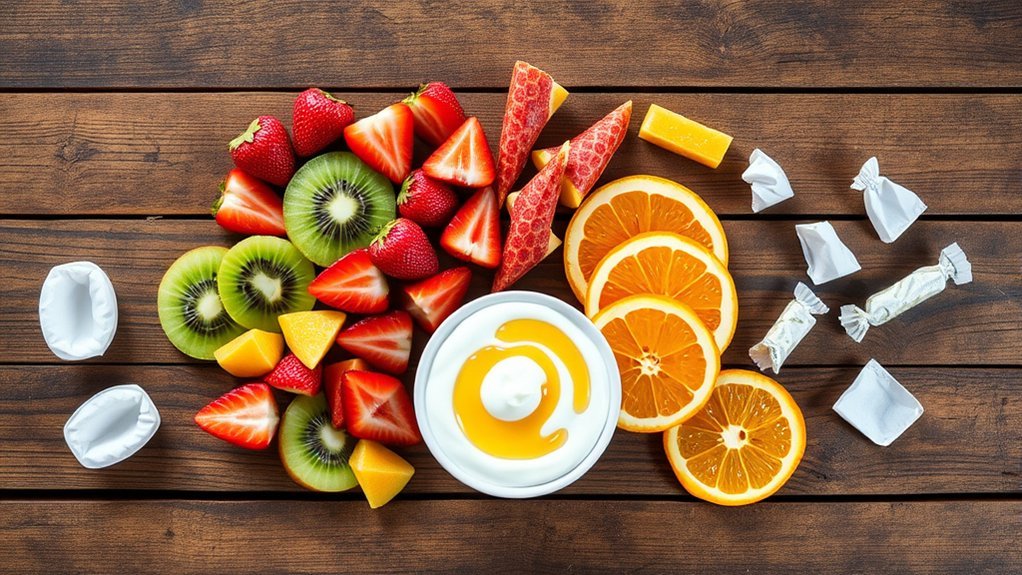When it comes to snacking, are you really making the healthiest choices? Understanding what qualifies as a nutritious snack can greatly impact your overall health. You’ll want to focus on whole foods packed with protein and fiber, while steering clear of processed options high in sugar and unhealthy fats. But how do you balance your portion sizes and make informed decisions? Let’s explore the do’s and don’ts of healthy snacking to find out.
Understanding Nutritional Labels
How can you make informed choices when snacking? Understanding nutritional labels is essential. Start by checking the serving size; it helps you gauge how much you’re actually consuming. Next, look at the calories per serving, as this can impact your overall daily intake. Pay attention to macronutrients—fats, carbohydrates, and proteins. Opt for snacks with healthier fats and higher protein content for sustained energy. Don’t overlook sugars; added sugars can quickly increase calorie counts without nutritional benefits. Finally, examine the ingredient list. Shorter lists with recognizable ingredients typically indicate healthier options. By analyzing these components, you can make smarter snacking decisions that align with your dietary goals and preferences, ultimately supporting a balanced and nutritious lifestyle.
Choosing Whole Foods Over Processed Snacks
When you choose whole foods over processed snacks, you prioritize nutrient density and overall health benefits. Whole foods, like fruits, vegetables, nuts, and whole grains, are rich in vitamins, minerals, and fiber, which contribute to improved digestion and sustained energy levels. They contain fewer additives and preservatives, helping to minimize the risk of adverse health effects associated with artificial substances. In contrast, processed snacks often have high levels of sugar, unhealthy fats, and sodium, which can lead to weight gain and chronic diseases. By opting for whole foods, you’re not only fueling your body with essential nutrients but also promoting long-term health. Making this switch can greatly impact your overall well-being and enhance your snacking experience.
Balancing Portion Sizes
Balancing portion sizes is essential for maintaining a healthy snacking routine. When you snack, it’s easy to lose track of how much you’re consuming. To avoid overeating, consider using smaller bowls or containers to limit your portions. Research shows that visual cues play a significant role in how much we eat; a smaller plate can trick your brain into thinking you’ve had enough.
Aim for snacks that fit within a range of 100 to 200 calories, depending on your daily needs. This strategy helps you satisfy hunger without derailing your overall nutrition. Keep in mind that portion control doesn’t mean deprivation; it’s about enjoying your food while staying mindful of your intake. Balance is key to successful snacking.
Incorporating Protein and Fiber
Incorporating protein and fiber into your snacks not only enhances their nutritional value but also helps keep you feeling full longer. Protein is essential for muscle repair and growth, while fiber aids digestion and promotes satiety. Consider snacks like Greek yogurt with berries, which combines protein and fiber, or hummus with carrot sticks for a crunchy, satisfying treat. Nuts and seeds are also excellent sources, providing healthy fats along with protein and fiber. When selecting snacks, aim for a balance of both nutrients to maintain energy levels and curb cravings. By making these choices, you’ll support your overall health and make snacking a more fulfilling experience. Remember, variety is key to enjoying these nutritious options!
Being Mindful of Sugar and Sodium Content
While enjoying snacks can be a delightful experience, it’s crucial to be mindful of their sugar and sodium content. Excessive sugar can lead to weight gain and metabolic issues, while high sodium levels may contribute to hypertension and cardiovascular problems. When choosing snacks, opt for those lower in these ingredients.
Here’s a quick comparison of common snack types:
| Snack Type | Sugar Content (g) | Sodium Content (mg) |
|---|---|---|
| Granola Bar | 8 | 120 |
| Potato Chips | 1 | 200 |
| Yogurt (flavored) | 15 | 50 |
| Fresh Fruit | 10 | 1 |
| Mixed Nuts | 2 | 150 |
Frequently Asked Questions
What Are Some Quick and Easy Healthy Snack Ideas?
You can grab Greek yogurt with berries, apple slices with almond butter, or veggies with hummus. Try air-popped popcorn or a handful of nuts for a quick energy boost that’s satisfying and nutritious.
How Can I Prepare Snacks in Advance?
Imagine a garden where snacks bloom. You can prepare them in advance by chopping veggies, mixing nuts, or portioning yogurt. Store in airtight containers, and you’ll always have tasty, nutritious options ready to enjoy.
Are There Healthy Snack Options for Kids?
Yes, there are plenty of healthy snack options for kids. Consider fruits, yogurt, whole-grain crackers, or veggie sticks with hummus. These choices provide essential nutrients while keeping them energized and satisfied throughout the day.
Can I Snack While Trying to Lose Weight?
Yes, you can snack while losing weight. Choose nutrient-dense options like fruits, veggies, or nuts, and watch portion sizes. Snacking wisely can help curb hunger and maintain energy without sabotaging your weight loss efforts.
What Are Some Common Snack Myths to Avoid?
You should avoid myths like skipping meals boosts metabolism or low-fat snacks are always healthier. Remember, moderation and balance are key. Focus on whole foods rather than processed options for effective snacking while maintaining a healthy lifestyle.
Conclusion
In the quest for healthy snacking, it’s ironic how the simplest choices often lead to the best outcomes. By choosing whole foods rich in protein and fiber, you not only nourish your body but also sidestep the pitfalls of processed snacks. Remember, moderation is key, so those tiny portions you scoff at might just be your best allies. In a world of excess, embracing the humble snack can be your secret weapon for a balanced diet.
